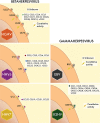Chemokine Subversion by Human Herpesviruses
- PMID: 30165356
- PMCID: PMC6289880
- DOI: 10.1159/000492161
Chemokine Subversion by Human Herpesviruses
Abstract
Viruses use diverse molecular mechanisms to exploit and evade the immune response. Herpesviruses, in particular, encode functional chemokine and chemokine receptor homologs pirated from the host, as well as secreted chemokine-binding proteins with unique structures. Multiple functions have been described for herpesvirus chemokine components, including attraction of target cells, blockade of leukocyte migration, and modulation of gene expression and cell entry by the virus. Here we review current concepts about how human herpesvirus chemokines, chemokine receptors, and chemokine-binding proteins may be used to shape a proviral state in the host.
Keywords: Chemokine receptors; Chemokines; Viral infection.
© 2018 S. Karger AG, Basel.
Figures



Similar articles
-
Modulation of chemokine activity by viruses.Curr Opin Immunol. 2010 Aug;22(4):482-7. doi: 10.1016/j.coi.2010.06.004. Epub 2010 Jul 1. Curr Opin Immunol. 2010. PMID: 20598516 Free PMC article. Review.
-
Subversion of cytokine networks by virally encoded decoy receptors.Immunol Rev. 2012 Nov;250(1):199-215. doi: 10.1111/imr.12009. Immunol Rev. 2012. PMID: 23046131 Free PMC article. Review.
-
Chemokines encoded by herpesviruses.J Leukoc Biol. 2017 Nov;102(5):1199-1217. doi: 10.1189/jlb.4RU0417-145RR. Epub 2017 Aug 28. J Leukoc Biol. 2017. PMID: 28848041 Free PMC article. Review.
-
Piracy on the molecular level: human herpesviruses manipulate cellular chemotaxis.J Gen Virol. 2016 Mar;97(3):543-560. doi: 10.1099/jgv.0.000370. Epub 2015 Dec 14. J Gen Virol. 2016. PMID: 26669819 Review.
-
Immune modulation by virus-encoded secreted chemokine binding proteins.Virus Res. 2015 Nov 2;209:67-75. doi: 10.1016/j.virusres.2015.02.028. Epub 2015 Mar 17. Virus Res. 2015. PMID: 25791735 Review.
Cited by
-
Coronavirus Porcine Epidemic Diarrhea Virus Utilizes Chemokine Interleukin-8 to Facilitate Viral Replication by Regulating Ca2+ Flux.J Virol. 2023 May 31;97(5):e0029223. doi: 10.1128/jvi.00292-23. Epub 2023 May 3. J Virol. 2023. PMID: 37133374 Free PMC article.
-
Cell surface RNA virus nucleocapsid proteins: a viral strategy for immunosuppression?Npj Viruses. 2024 Sep 2;2(1):41. doi: 10.1038/s44298-024-00051-3. Npj Viruses. 2024. PMID: 40295865 Free PMC article. Review.
-
HHV-6 Infection and Chemokine RANTES Signaling Pathway Disturbance in Patients with Autoimmune Thyroiditis.Viruses. 2020 Jun 26;12(6):689. doi: 10.3390/v12060689. Viruses. 2020. PMID: 32604892 Free PMC article.
-
Intersections between innate immune response and gastric cancer development.World J Gastroenterol. 2023 Apr 21;29(15):2222-2240. doi: 10.3748/wjg.v29.i15.2222. World J Gastroenterol. 2023. PMID: 37124883 Free PMC article. Review.
-
Herpesviruses and the Type III Interferon System.Virol Sin. 2021 Aug;36(4):577-587. doi: 10.1007/s12250-020-00330-2. Epub 2021 Jan 5. Virol Sin. 2021. PMID: 33400088 Free PMC article. Review.
References
-
- Vischer HF, Vink C, Smit MJ. A viral conspiracy: hijacking the chemokine system through virally encoded pirated chemokine receptors. In: Lane TE, Chemokines and Viral Infection, editor. Berlin: Springer; 2006. pp. pp 121–154. - PubMed
-
- González-Motos V, Kropp KA, Viejo-Borbolla A. Chemokine binding proteins: an immunomodulatory strategy going viral. Cytokine Growth Factor Rev. 2016;30:71–80. - PubMed
-
- Steiner I, Kennedy PGE, Pachner AR. The neurotropic herpes viruses: herpes simplex and varicella-zoster. Lancet Neurol. 2007;6:1015–1028. - PubMed
Publication types
MeSH terms
Substances
Grants and funding
LinkOut - more resources
Full Text Sources
Other Literature Sources

